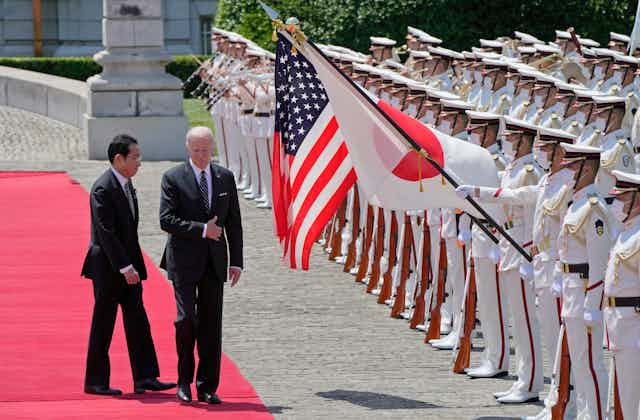Japanese Prime Minister Fumio Kishida is set to sit down with President Joe Biden at the White House on Jan. 13, 2023.
The bilateral meeting in the U.S. is the final stop for Kishida in a five-day tour of allies that has also seen him visit France, Italy, the U.K. and Canada. It comes as Japan takes over the presidency of the G-7, with leaders of the seven largest economies due to meet in Hiroshima in May.
It also marks the first visit to the White House by a Japanese prime minister since the country revamped its defense priorities with the release of its National Security Strategy in December 2022. The new strategy supports a more robust and assertive security stance by Japan in the face of shifting geopolitical and domestic realities. The new defense plan forms the backdrop to the meeting with Biden.
As an expert on U.S.-Japan relations, I believe the National Security Strategy is the lens through which the meeting should be viewed, with a focus on four key items.
1. Underscoring the US-Japan alliance
The preeminent goal of the leaders’ meeting will be to emphasize the strength and importance of the U.S.-Japan alliance, both rhetorically and in substance.
The two governments will likely seek to display to both foreign and domestic audiences that Japan and the U.S. are in lockstep on foreign policy priorities. Both countries have framed “democracy” and “the rule of law” as common values underpinning the U.S.-Japan alliance, and there is no reason to believe that Biden or Kishida will deviate from that line, especially regarding their shared vision of a “free and open Indo-Pacific.”
Given the context of the meeting, such rhetoric can have substantive consequences and shed some light on how the alliance is being positioned within, and may evolve after, Japan’s latest shift in its defense strategy. Japan’s National Security Strategy is ambitious in its development of new strategic capabilities, including counterstrike measures, and represents unprecedented financial commitments from the Japanese government. Yet Japan can only achieve its new defense goals in close cooperation with the U.S. As a result, Japan will be looking for Biden’s fulsome show of support for both the bilateral alliance and Japan’s new defense strategy.
But the meeting isn’t all about satisfying Japanese concerns – framing the U.S.-Japan alliance as solid and stable supports Biden’s objective of reinvigorating relationships with U.S. allies and acts as a deterrence to any country seeking to disrupt the status quo in the Indo-Pacific region.
2. Addressing regional tensions
Over the past decade, the security environment in Asia has become more dangerous.
Since the Russian invasion of Ukraine in 2022, this is even more so the case. North Korea has become emboldened, knowing that Russia and China are unlikely to act against its provocations in the current geopolitical environment. It is telling that North Korea tested more missiles in 2022 than in any previous year.
Meanwhile, Chinese president Xi Jinping has reasserted his desire of reuniting Taiwan with the mainland during his tenure, holding large-scale military exercises around the island mere days before the U.S.-Japan meeting.
The U.S. views the steps being laid out in Japan’s new defense strategy to be important for regional security as a form of deterrence against aggression from China and North Korea and as a means for the U.S. and Japanese militaries to work together more seamlessly in the event of conflict in the region. The White House meeting provides an opportunity for Biden and Kishida to reiterate their common regional concerns and display a united resolve against any saber-rattling in the region.
3. Confronting Russian aggression
As both the current G-7 president and as a non-permanent member of the United Nations Security Council for 2023-24, Japan will have to confront the main geopolitical drama playing out on the global stage: the Russian war in Ukraine. The new National Security Strategy illustrates how the Japanese government’s view of Russia has shifted, from a potential strategic partner to a strategic threat. Japan has also voiced concerns that Russia could join forces with China in ways that undermine regional security.
These changes in the Japanese government’s perception of Russia bring it more in line with the U.S. position and will likely be reflected in the way in which the Russian invasion of Ukraine is addressed between the two leaders at the White House meeting.
4. Economic security
In 2021, Japan created a cabinet-level post of economic security minister, and the importance of insulating the economy from outside threats was reiterated in the National Security Strategy.
A priority is working toward securing supply chain resilience in the face of existing – or potential – disruptions from pandemics, climate change, military conflict or politically motivated actions, such as withholding needed goods or services by other governments.
Both the U.S. and Japan have emphasized that a crucial part of supply chain resilience is partnering with like-minded nations. As such, a plan for enhanced economic and technological cooperation is among the topics likely to be discussed by the two leaders.
… so how much of this is about China?
The U.S.-Japan bilateral summit is not all about China – conspicuously, China was not mentioned by name in either the White House announcement of the planned content of Friday’s meeting between Biden and Kishida or in the White House overview of the two leader’s last meeting in Cambodia in November 2022.
Yet, China looms large for the U.S. and Japan in each of these four areas, as both seek to enhance the two nations’ defense, diplomatic and economic ties – and will likely never be far from the surface of what is being discussed.

